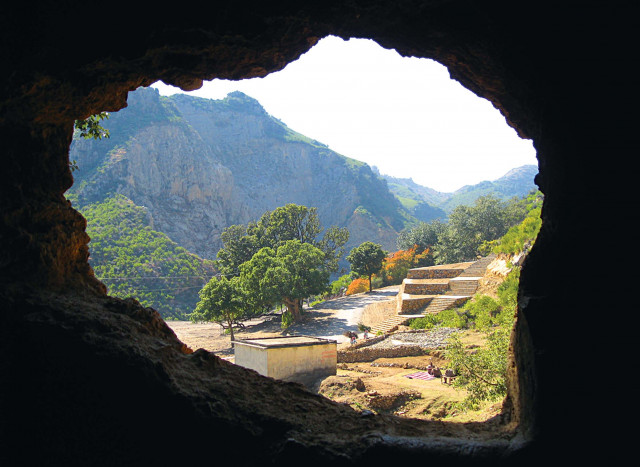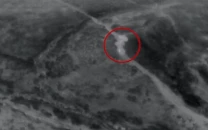Securing Islamabad’s past: In fight with greed, heritage wins first round
Modalities of the plan to hand over the Buddhist heritage site to CDA will be finalised on Thursday.

The ancient caves of Shah Allah Ditta in the suburbs of Islamabad are among the most treasured archaeological sites of the capital that give a past to a city just more than a half century old. However, the site faced threats from land developers had the Capital Development Authority not woken to the danger in time.
The site of the caves had been leased for commercial development but luckily the civic authorities were alerted in time by the citizens group, media and Evacuee Trust Property Board to cancel the lease agreement for the preservation of the heritage site.
Dr Suleman Sheikh, Director General Environment Wing of CDA said that after the devolution of culture ministry and its affiliate Federal Archeological Department to the provinces under the 18th Constitutional Amendment it was the civic agency’s desire to ensure the preservation of these archeological sites.
“The response of Evacuee Trust was positive and the modalities of the plan to hand over the site to CDA will be finalized on Thursday, he added.
Located at the gateway to Gandhara civilization and the foothills of the might Himalayas, the capital is home to several archaeological sites, which not only provide a peek into the past but are a treasure for the researchers to uncover facts about this region.
The caves in the suburbs of Islamabad are one such place and according to recent studies there might be more of such sites in the area.
Earlier, members of the Capital Citizens Committee had raised alarm about the danger the site has been facing and informed CDA Chairperson Imtiaz Inayat Elahi after noticing suspicious activities near the heritage site. They noticed that a restaurant was being planned on the hill above the 2,400-year-old caves and the cluster of Banyan trees at their entrance.
The committee warned the Department of Archaeology and Museums to protect the caves from private land developers in the area.
“It will be a crime if any harm comes to them,” said Fauzia Minallah, a writer, painter, who campaigns for the preservation of heritage sites and also authored a book documenting these sites.
Help from the court of law
On the other hand help from the court of law was also demanded to stall “destruction of such sites”. The Lahore High Court Rawalpindi Bench on December 15, 2010 put on halt the construction of a picnic spot near a heritage site in the Margalla Hills on the outskirts of the city.
Justice Ijaz Ahmed stayed the construction activities. A petitioner, Absarul Haq Satti, in his petition filed with the court had argued that the caves were archaeological sites and national assets. The government, he maintained, had decided to protect the caves. But CDA approved a plan to build restaurants and a picnic spot at the heritage site, the petition said.
“The concerns shown by citizens were correct and CDA wants to address such problems on priority basis,” Dr Sheikh said, adding, “we want to develop a park near the caves to facilitate visitors.” The city authorities, according to him, are also working to preserve the old trees near Margalla National Park area.
Stakeholders unite for preservation
Moreover, Deputy DG Environment of CDA Malik Aulya Khan said that it was decided at a meeting on Wednesday that for the preservation of the caves and other such sites, all stakeholders would remain in close contact with each other in future.
The meeting was attended by the officials of the CDA, Evacuee Trust Property Board, Archaeological Department and Taxila Institute of Asian Civilization, Quaid-i-Azam University.
“There are many such sites in the territory of the capital city that needs attention,” said Khan. A research of Taxila Institute of Asian Civilization is also underway to find ways to explore more sites. The civic agency is coordinating with the institute for identifying and conserving such places, he informed.
Researchers at the Archaeology Department recently have discovered two more ancient sites in the vicinity of Shah Allah Ditta caves, he said. As per their estimation, Dr Sheikh said, people used to live in those caves some two millions years ago.
Facts about Shah Allah Ditta Village
Buddhist caves are located on the route leading towards Khanpur next to the shrine of Shah Allah Ditta.
Shah Allah Ditta Village is believed to be more then 700 years old and was used as route from Kabul to Gandharan city of Taxila by Sher Shah Suri and other Mughal rulers emperors.
About 6,000 kanals land have been purchased by the private housing societies of sectors D-13, E-13 and C-13.
The federal government has only 30 kanals of land in and around Shah Allah Ditta.
CDA plans to preserve the Buddha caves as well as the adjacent garden known as ‘Sadhu ka Bagh’.
Japanese embassy has reportedly offered to provide funds for the preservation of Shah Allah Ditta caves.
Archaeological evidence indicates that the caves and the platform-like formations surrounding the area were first used for meditation by Buddhist monks and later by Hindu sadhus before Muslim ascetics took over during the Mughal period.
The road next to the caves that leads to the top of the mountain is said to be built on the exact path followed by Mughal Emperor Sher Shah Suri .
Relics of the Buddhist era dating back to the 8th century can be found here along with burnt diyas and trees with amulets tied to them.
Published in The Express Tribune, September 8th, 2011.



















COMMENTS
Comments are moderated and generally will be posted if they are on-topic and not abusive.
For more information, please see our Comments FAQ